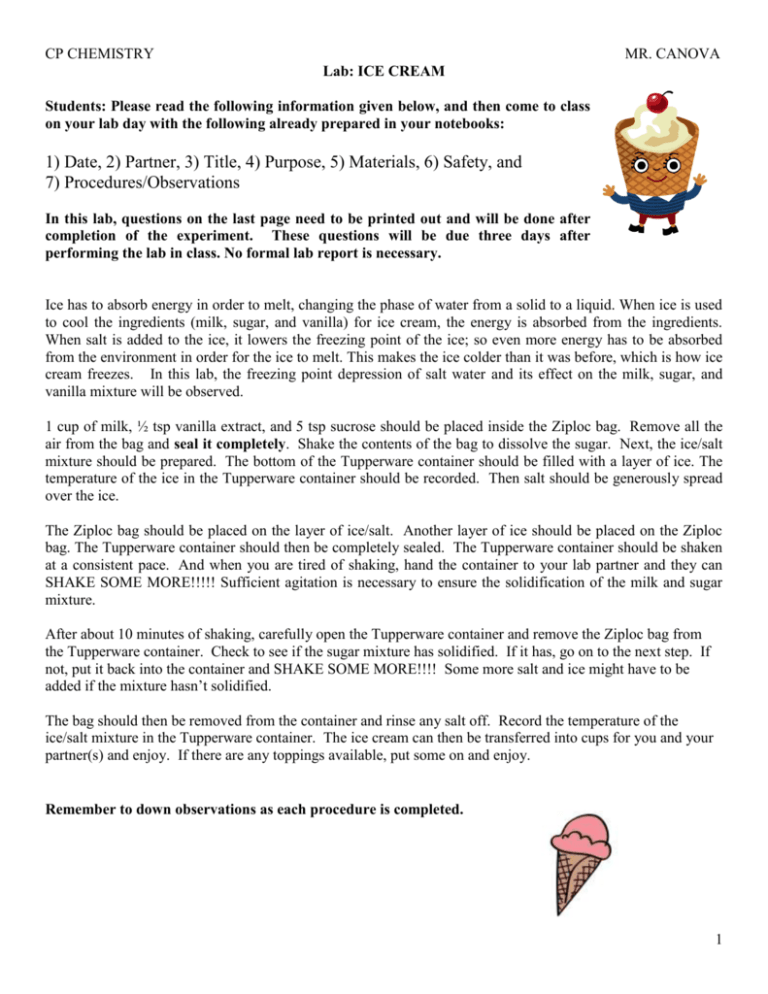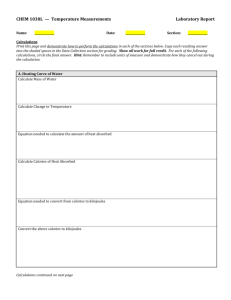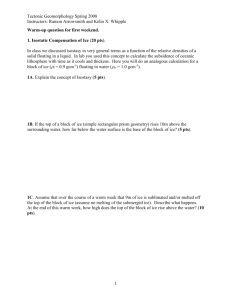CP CHEMISTRY
advertisement

CP CHEMISTRY MR. CANOVA Lab: ICE CREAM Students: Please read the following information given below, and then come to class on your lab day with the following already prepared in your notebooks: 1) Date, 2) Partner, 3) Title, 4) Purpose, 5) Materials, 6) Safety, and 7) Procedures/Observations In this lab, questions on the last page need to be printed out and will be done after completion of the experiment. These questions will be due three days after performing the lab in class. No formal lab report is necessary. Ice has to absorb energy in order to melt, changing the phase of water from a solid to a liquid. When ice is used to cool the ingredients (milk, sugar, and vanilla) for ice cream, the energy is absorbed from the ingredients. When salt is added to the ice, it lowers the freezing point of the ice; so even more energy has to be absorbed from the environment in order for the ice to melt. This makes the ice colder than it was before, which is how ice cream freezes. In this lab, the freezing point depression of salt water and its effect on the milk, sugar, and vanilla mixture will be observed. 1 cup of milk, ½ tsp vanilla extract, and 5 tsp sucrose should be placed inside the Ziploc bag. Remove all the air from the bag and seal it completely. Shake the contents of the bag to dissolve the sugar. Next, the ice/salt mixture should be prepared. The bottom of the Tupperware container should be filled with a layer of ice. The temperature of the ice in the Tupperware container should be recorded. Then salt should be generously spread over the ice. The Ziploc bag should be placed on the layer of ice/salt. Another layer of ice should be placed on the Ziploc bag. The Tupperware container should then be completely sealed. The Tupperware container should be shaken at a consistent pace. And when you are tired of shaking, hand the container to your lab partner and they can SHAKE SOME MORE!!!!! Sufficient agitation is necessary to ensure the solidification of the milk and sugar mixture. After about 10 minutes of shaking, carefully open the Tupperware container and remove the Ziploc bag from the Tupperware container. Check to see if the sugar mixture has solidified. If it has, go on to the next step. If not, put it back into the container and SHAKE SOME MORE!!!! Some more salt and ice might have to be added if the mixture hasn’t solidified. The bag should then be removed from the container and rinse any salt off. Record the temperature of the ice/salt mixture in the Tupperware container. The ice cream can then be transferred into cups for you and your partner(s) and enjoy. If there are any toppings available, put some on and enjoy. Remember to down observations as each procedure is completed. 1 CP CHEMISTRY Name______________________________________ Period_________________ MR. CANOVA Date_____________ Lab Group #_______ Lab: Ice Cream Answer the following questions in complete sentences: 1. Describe what was happening to the ice/salt mixture in the container. (3 pts) Questions: 2. Describe what was happening to the milk mixture inside the Ziploc bag? (2 pts) Review Section 16.3 in your textbook (Colligative properties of solutions) and answer the following questions: 3. Define Colligative property. (1 pt) 4. How does adding a solute to a solvent affect its vapor pressure? Its freezing point? Its boiling point? (3 pts) 5. What happens to table salt when it dissolves in water? (3 pts) 2 CP CHEMISTRY Name______________________________________ Period_________________ MR. CANOVA Date_____________ Lab Group #_______ Lab: Ice Cream (continued) 6. How many ions are formed in solution when MgCl2 dissolves in water? When AlCl3 dissolves? (2 pts) 7. The addition of which salt, NaCl, MgCl2, or AlCl3, would raise the boiling point of water the most? The least? Explain. (3 pts) 8. Explain how a decrease in the vapor pressure of a solution results in an increase in its boiling point. (3 pts) 3







